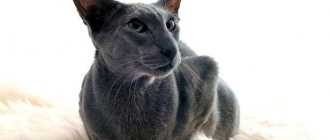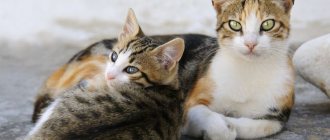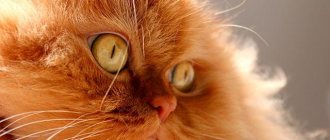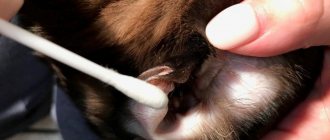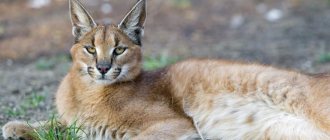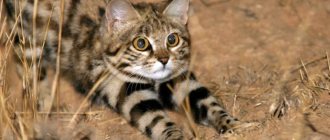Keeping a caracal at home
In ancient India, as well as in Persia, the steppe lynx was specially tamed for hunting wild animals such as small antelope, hares, pheasants and peacocks.
This type of hunting was popular mainly among poor people, since caracals were much cheaper than cheetahs, and also did not require special care and a lot of food. It was very easy to keep such an animal, and a properly tamed steppe lynx is a kind and affectionate animal. Today, keeping such a large predatory cat at home has become a sign of wealth and is very prestigious. Many wealthy people buy unpretentious caracals as exotic pets. However, the cost of such a graceful animal is very high, so not everyone can afford to purchase it and keep it at home.
How and in which nurseries to buy a caracal kitten
Having decided to purchase a domestic caracal, you need to select proven and well-established nurseries. To do this, just read reviews on the Internet and compare the cost of kittens on different sites. When purchasing a kitten, be sure to check the breeding license. The seller is also obliged to issue the buyer a veterinary certificate. passport (which must contain all vaccinations) and a sales contract.
Domestic caracal
Caracals are easily tamed and were popular pets in ancient times in Egypt, Asia, India and other countries. Now the fashion for caracals as pets is gradually returning. This cat breed is not cheap - the price of a purebred kitten from a nursery in Russia is about 0.5 million rubles. A kitten of the Caraquet breed, a hybrid of a Caracal with a domestic cat, will cost less - from 100,000, depending on the generation and pedigree.
Keeping a caracal at home will require effort. The animal needs a personal living space of at least 15 square meters. You will have to give the cat a separate room or build a large enclosure with a run. The room or enclosure must be at least 2.5 meters high. Inside you need to make shelves and arrange the branches at different heights so that the predator can climb to its pleasure.
Cats easily learn to use the litter box, but they do not bury themselves, so you will need to clean up after the animal regularly. You will definitely need a scratching post, otherwise you will have to regularly trim your nails at the veterinarian. Like other pets, a cat needs to be vaccinated and possibly neutered. It is better to take the animal to the veterinarian for procedures. Given the size of the cat, a steady hand will be needed.
By nature, domestic caracals are very active and energetic cats; they love to play and get along with cats and dogs relatively easily. The animal should be fed food close to its natural diet:
- meat, and unpeeled (with feathers, entrails, wool, bones);
- sea fish
- eggs
- pureed vegetables (a little) - pumpkin, zucchini, carrots, cabbage
A caracal eats approximately 300-800 grams of food per day. You won't be able to feed him ready-made food.
While admiring the grace, power and beauty of the animal, we should not forget that the caracal is still a predator by nature. Do not leave your cat alone with small children, poultry or rodents. An animal needs to be raised and trained from an early age, and given a lot of attention. If you don’t do this, you may find yourself locked in one house with a beautiful and powerful, but wild cat.
Character of the domestic caracal
The character of a caracal is largely determined by upbringing. Unlike other cats - with the possible exception of the cheetah - the caracal is highly trainable and recognizes the “rules of subordination” if the owner takes the time to instill them in the kitten at an early age. The caracal is a predator, and it is very important that in its manifestations the animal does not go beyond what is permitted. Caracals are not prone to mood swings and manifestations of anger - however, they are not prone to traditional manifestations of feline tenderness either. They are very curious, energetic and love to play. The owner’s task is to make sure that the manifestation of these traits does not become destructive, for example, he does not get into the habit of biting household members for fun or destroying furniture. In the first two years, the kitten can be quite emotional, this should be taken into account and patience and perseverance should be shown. The help of professionals will not be superfluous. Rudeness and punishment are contraindicated.
As in the wild, caracals jealously defend their territory. Even a well-bred animal marks it from time to time, and both cats and cats do this. Tolerant of intrusion by the owner and members of his family, he can react aggressively to strangers. The caracal is a strong animal, and it is not easy to cope with it.
Caracals get along quite difficult with small children. Especially if the baby likes to pull the animal’s tail or ears. A fluffy kitten still has roots and can respond to aggression with aggression.
Where can I buy
It is best to buy caracals in specialized nurseries,
where they are bred to be domesticated. There you can see how the parents behave, how they get along with people, and look at the relatives of the future pet.
Kittens from nurseries are usually litter box trained and accustomed to handling and interacting with humans.
Zoos sometimes also sell caracals, but such cats most often view humans not as an owner or friend, but as a source of food. It is very difficult to instill discipline in such animals.
You should not buy animals that have been caught in the wild - they are more difficult to tame than those born and raised near people.
Caracal
Among the huge selection of cat breeds bred by crossing different purrs, people are still actively looking at wild pets. There is something unbridled and mysterious about them, a harmonious combination of a hunter and a gentle beast. The caracal cat is considered one of the rarest and most beautiful breeds today . At first glance, it may seem that such fluffies are created exclusively for living in the wild. However, they feel quite comfortable around people, demonstrating friendliness and playfulness to everyone. Today you will learn everything about the Caracal cat breed, including their character, external features, as well as the rules for caring for such unusual pets.
Content Features
This is a very active and curious cat. Add to this its size and it becomes clear that keeping a caracal in a small apartment is not the best solution. It is even more impossible to lock an animal in a cage; it is much better to give it a separate room. Aviary keeping is not suitable in winter - a warm room is needed, so you will still have to allocate a room for your pet. The best option is a room with access to a specially landscaped (and fortified) area.
It is necessary to satisfy their need for movement and games, otherwise the caracal will do it for you (for example, destroying all the furniture in the house). They love to jump and climb, and enjoy playing with toys (suitable for large dogs or children's toys).
Caracals can be trained to walk on a leash and use a litter tray. The litter will have to be changed every day since these cats do not bury their excrement.
They shed all year round; it is necessary to brush your pet from time to time. They take care of their hygiene themselves; they view bathing more as fun.
Feeding caracals
Caracals are strict predators. They eat only meat and it is impossible to replace it with any other products without harm to health. To best meet the cat's needs, the diet should include carcasses of rodents and birds.
Day-old chicks are sold at poultry farms; they must be given whole, with feathers and bones. In the same form, you can also feed adult birds - chickens, ducks, quails.
A good food for a caracal would be a rabbit (along with its entrails) or rats. These can be purchased at places that sell snake food. It is better to choose beef or lamb that has enough bones and membranes. Feeding the pulp alone may cause diarrhea.
You can treat the caracal with dry food or a piece of cheese, but you cannot feed the cat only with them.
These cats usually digest milk poorly. Caracals drink little; they get enough moisture from raw meat.
They do not need constant access to water, but they should be offered a drink from time to time.
History of the discovery of the caracal species
The caracal is a predator of the cat family. Africans call the caracal the Barbary lynx. In general, caracals are also called desert cats and steppe lynxes. For a long time, caracals were classified specifically as lynxes, because in appearance these species are very similar. However, later genetic characteristics were found in desert cats that distinguish them from other species. The name “caracal” is translated from the Turkmen language as “black ear” (karakulak).
The caracal got its name from its unusual ears.
Once upon a time, in ancient times, hunters (India, Africa, Persia) took caracals with them to hunt. Poor hunters could not afford to domesticate cheetahs, so the choice fell on small predators: ocelots and caracals. Steppe lynxes could easily catch game (peacocks, pheasants, etc.), hares and antelopes. Desert cats are gentle creatures, so they were easily tamed.
Due to the interesting history of the species, the caracal is still called the “poor man’s cheetah” in India. It is believed that anyone can tame the steppe lynx.
Caracal desert lynx
The caracal, or, as it is also called, the desert lynx, is a small predatory cat. As the name suggests, representatives of this breed live in deserts. The domestic caracal differs from other cats in its courage and love of freedom. The desert lynx is very graceful and beautiful. Therefore, lovers of elegance and exoticism will appreciate it.
In nature, caracals are found in various parts of the planet:
- African deserts;
- Asia;
- coast of the Caspian Sea;
- Türkiye;
- India;
- Dagestan.
The desert lynx lives in burrows and also in crevices. She is nocturnal. Compared to domestic cats, the caracal is not afraid of water.
Despite the prevalence of the animal, it, unfortunately, is gradually disappearing. The reason for this is a person who displaces the desert lynx from its usual habitat. To save the situation, caracals are kept in zoos and nature reserves.
When caracals are captured in captivity, they can be easily tamed and domesticated without any problems. Especially when it comes to a kitten. There are no problems with this. Of course, compared to domestic cats, the behavior of caracals will be somewhat different. This uniqueness is explained by the fact that by nature the desert lynx is a wild animal.
Appearance
The serval, also called the bush cat, has the pride and grace of an African predator. Its size is small compared to other African brothers and simply gigantic if we equate it to an ordinary domestic cat. The weight of spotted pets ranges from 8-18 kg. Height is 40-65 cm, and body length can reach 130 cm.
The head is relatively small, the muzzle is not elongated, but the ears are quite large, set high, and well-furred inside. The bridge of the nose and nose are wide. The eyes are almond-shaped and large. Servals are truly top models in the cat world. Their limbs are the longest in relation to the body, with the hind legs being slightly longer than the front ones.
The coat is short, thick and shiny. The main color is golden brown. On the chest, belly and face there are lighter areas, almost white, and the main decoration of the cat is contrasting black spots arranged in stripes. The color may have some differences depending on the geographical homeland. Servals from the steppe regions are distinguished by large spots and a light background, while forest cats are darker.
Serval hybrids
In captivity, servals sometimes mate with ordinary domestic cats. Based on such hybrids, a new breed was developed, which was called Savannah. There was also information about the appearance of a hypoallergenic breed with the beautiful name Asher. Subsequently, they turned out to be the same shrouds, the price of which was greatly exaggerated by the scammers. In addition, matings of bush cats with steppe lynxes and caracals are often quite successful. As a result, the so-called servicals or caravals are born.
Description of the home caracal
The caracal attracts attention with its combination of strength and grace. With a height at the withers of about half a meter, the weight of the animal reaches 20 kg.
- The long legs make its silhouette almost square, with the hind legs being slightly longer than the front ones. The tail looks shortened (half the length of the body), but not stubby.
- The coat is thick, short, rough, especially on the hind legs, slightly longer on the lower part of the body, with developed undercoat.
- The color ranges from sand to brown, turning on the belly into a much lighter tone with numerous small spots, which helps the caracal to remain invisible against the backdrop of scorched sand. Males are no different in color from cats, but a little more massive.
- The shape of the head is rounded, slightly elongated, like that of a lynx, but the ears are noticeably longer, and not only due to the tassels - their length can be 5 cm.
- The caracal's ears are most often a salt-and-pepper color, while those of the Namibian caracal are pure white, but the tassels are always jet black. The characteristic black “paths” give the muzzle a sad expression.
Where, from whom and how can I buy?
Typically, Caracal cats are purchased in order to emphasize their prestige and wealth.
To buy a kitten, you need to do the following:
Decide on the place of purchase. Call the seller and find out all the information about the kitten and arrange a meeting. Arrive at the agreed address and meet the seller. Ask for and study the documents for the cat
Pay attention to the condition of the animal. If everything suits you, then buy a caracal. If you want to have a caracal kitten at home, then there are three options where you can buy it:
If you want to have a caracal kitten at home, then there are three options where you can buy it:
- In the nursery.
- From the breeder.
- According to an advertisement placed on the Internet or in a newspaper.
The caracal is a rare breed of cat. In Russia it can only be purchased in large cities. For example, in Moscow there are nurseries that house rare breed animals:
- Murmulet.
- Golden Wild Savannahs.
- Antonika.
It is better to buy a caracal at the age of 3 to 6 months. Small kittens get used to the house faster.
Buying a caracal kitten, choice and price
Like other exotic animals, the caracal cannot be found at a bird market or on an online bulletin board under the query “caracal cat price in rubles.” The search for a kitten should begin through breeders of exotic animals or hybrid cat breeds, in specialized nurseries. In general, if you have the funds and the desire to buy a caracal, it is not difficult.
It is advisable to take caracals in home-type nurseries, and not in open-air cages. It is important that the baby is in constant contact with a person from birth. This does not guarantee, but it increases the likelihood that he will grow up to be tame, kind and affectionate.
It is recommended to buy a kitten before 6 months of age. Raised by a human, he will quickly get used to his new family and environment. In terms of adaptation, the caracal is similar to puppies; it is friendly, sociable and not as sensitive to changes in the usual routine and home, as, for example, servals.
You should not purchase animals from resellers, or from people who cannot provide an official package of documents.
It is immediately necessary to determine whether the kitten is needed as a pet or for breeding. Firstly, it affects the price. Secondly, if matings are not planned, it is better to castrate/sterilize the animal at 3-5 months, otherwise problems with marks, aggression and the desire to leave their native land cannot be avoided.
The price of a caracal kitten in official nurseries ranges from 8500-12000 dollars. As a rule, kittens for breeding are more expensive. Gender matters, a cat is often cheaper than a caracal cat, the price in Russia may also vary depending on the geography of the nursery.
Appearance
Externally, the caracal animal closely resembles a lynx. But at the same time, its size is much smaller, its color is monochromatic, and its overall physique is more graceful and slender. The body reaches a length of 65-80 centimeters, and the tail – up to 30 centimeters. At the withers, large individuals can have a height of up to 45 centimeters and weigh 15-20 kilograms.
The ears are so long that they appear disproportionately large on juveniles. They have a long tassel at the ends - up to 5 centimeters. The paws are covered with brush - hard, short hair makes running on cold and hot sand much easier.
In general, the fur is thick and short. On the one hand, this avoids problems with sand getting into the skin. On the other hand, it perfectly protects not only from the wind, but also from high temperatures, which are often observed in the steppe and desert. The color of the fur is uniform - reddish-brown or sandy on top, and white on the bottom. Black markings are visible on the muzzle. The ears (outside) and tassels are also black. In addition, in the wild you can see melanistic caracals - they are black in color, but are extremely rare.
Where does the caracal live?
Despite the telling name, these cats can be found not only among sand dunes and steppe feather grasses. Caracals live in forests and foothills. A flexible body and elastic paws allow steppe lynxes to deftly climb trees. From there you have a wide view of the conquered territories. By the way, their area can reach 340 km2 or more.
Caracals, like other cats, deftly climb trees.
To rest, the caracal prefers to look for holes or crevices in the rocks abandoned by other animals. If the animal likes the place, the desert lynx will return to such a refuge for many years.
It is noteworthy that males and females live separately, meeting only during mating and having offspring.
By nature, these animals are loners. Having reached sexual maturity in the first year of life, the caracal leaves its fellows to conquer its own territory.
Video: caracal
Caring for a caracal
This domestic lynx is very smart, energetic and quick-witted. But given that this is a predator, you need to ensure that the requirements are met clearly, and it is also necessary to adhere to the principle of consistency. It is necessary for the cat to feel the authority of the owner and maintain subordination with him. It will be useful to establish certain rules of behavior in the house.
It is important to castrate or sterilize your cat if there are no plans to reproduce the species - domestic lynxes will try to escape and mercilessly mark their territory when they mature. This means the apartment where they will live may suffer. You don’t need to brush your domestic lynx often; once a week will be enough.
It is more convenient to do this using a furminator. Ears and eyes also need to be checked no more than once a week, and they can be cleaned as needed, so as not to once again cause unpleasant emotions in animals. Cats do not take well to “manicures”; in catteries, claws are often removed with a laser. If claws are still present, you need to find a log-shaped scratching post for the caracal.
You don’t need to brush your domestic lynx often; once a week will be enough. It is more convenient to do this using a furminator. Ears and eyes also need to be checked no more than once a week, and they can be cleaned as needed, so as not to once again cause unpleasant emotions in animals. Cats do not take well to “manicures”; in catteries, claws are often removed with a laser. If claws are still present, you need to find a log-shaped scratching post for the caracal.
Species features of caracals
Habitat
The natural habitat of caracals is savannas and semi-deserts. In the desert, it can go further than its close relative, the serval, due to the fact that the caracal is better adapted to do without water.
Lifestyle
Caracals are nocturnal predators. Hunger can force them to hunt and leave the den during daylight hours; this usually happens in winter and early spring.
Caracals live strictly alone. During mating, a cat can be visited by up to three different cats, but then she raises the cubs on her own for up to 3–4 months.
Grown-up kittens leave to find unoccupied territory - caracals are jealous of protecting their hunting grounds. They are usually larger in caracal cats than in cats. Life expectancy is 15–20 years.
Hunting
Caracals hunt stealthily - they track prey and attack when it is at a short distance.
Long-legged and flexible, caracals are excellent jumpers, and their retractable claws help them catch up to several birds from a group in one jump. In addition to birds, they hunt a variety of game - from small gerbils to lambs. A predator that enters the territory of caracals can also become lunch. They can eat a fox or even a small dog.
If possible, the caracal will happily feed on domestic animals - ducks, chickens or kids. Cats eat their prey on the ground, burying the uneaten food in sand and leaves.
Appearance of caraquets
Caraquets have a bright individual appearance. They inherited many features from the steppe cat: high limbs, a proportionally developed muscular body, large paws and a small fold of fat on the abdomen. The length of an adult cat is up to 90 cm, height is about 50 cm, weight is up to 15 kg (on average 9-12 kg).
The muzzle is small in relation to the body. The eyes are round and very expressive, largely due to the darkly pigmented eyelids. Above the eyes, closer to the inner corner, there are two dark vertical markings, characteristic of wild cats. The nose is quite wide with a large dark lobe, which, like a caracal, may have a light spot. The ears are large, set high, very mobile. The outer side of the ear is covered with dark hair, and the inside is light, but the main decoration is the noticeable black tassels at the tips.
The color is brown with double or triple ticking. On the chest, belly, and inside of the paws it is lighter, almost white with dark markings. Dark stripes may be visible on the tail and paws.
Hybrids F1, F2... F5 - what does this mean?
The first generation of hybrids, in this case a caracal and an Abyssinian cat, are designated as F1 - these are 1st generation kittens that have about 50% of the blood of the wild parent. F1 specimens are the most beautiful and expensive, and are also very valuable for the breeder. Many of them become the founders of new lines, which makes it possible to eliminate inbreeding (inbreeding) in the future.
Second generation kittens (F2) are born from an F1 cat and a cat of the breed chosen by the breeder. About 30% of wild blood inherits this generation. In what follows, notations are made using the same principle. The letter F is followed by a number indicating the generation. At each subsequent stage, the blood of wild cats becomes more diluted, and their appearance, as a rule, becomes more domesticated.
Description and standards of caracal
Above we said that there are 9 subspecies of caracal, although a person far from botany or felinology is unlikely to notice the difference from photographs.
Any steppe lynx is very large and tall. You can’t call her massive: her natural grace cannot be hidden, her heaviness does not catch the eye.
The elongated head is crowned with elongated narrow ears with the most charming tassels at the tips. There is a decent distance between the ears and they stand strictly vertical. On the back of the ears the skin is either flat black or gray.
The body looks lean and short. The tail is shorter than half the body. The graceful caracal moves on high, lean limbs. The paws are massive and large.
The color of the coat is beautiful, reminiscent of ocher mixed with sand. The villi are short and reddish. The fur on the belly and chest is longer. Yellow stripes under the eyes. There are no differences in color between males and females.
Dimensions and weight of caracals
The tall caracal cat reaches half a meter at the withers in adulthood. Pretty solid! The weight of cats reaches 15-21 kg. The weight of females is less than that of males. If such a pet sits on his lap, the owner will immediately feel every kilogram of the handsome man.
Caracal hybrids
Several breeders in Russia, Ukraine and the USA have bred and continue to breed caracal-domestic cat hybrids. Moreover, in the USA the Abyssinian cat is used.
global $ads_google; //data-ad-slot=”2475549904″ $ads_google = empty($ads_google) ? false : true; ?> if ($ads_google == false) {?>
$ads_google = true; ?> } ?>
The experimental breed was named caracat (cara(cal)+cat), which indicates its origin. The first generation hybrid is the most difficult to breed, because the male caracal does not accept representatives of another species for the purpose of reproduction. But breeders are persistent; today there are cats in the world that look like caracals, with an affectionate character and smaller dimensions.
For some reason, dogs don’t perceive Carket as a cat. For them, this is a creature equivalent to them, and relationships are built on the dog-dog principle
Another hybrid is the servical, or ser-caracal. In this case, breeders took a male from a serval and a female from a caracal. The cat's appearance resembles a serval, and its ears come from Caracal blood. This is a completely new breed, a pure experiment.
Enemies
Caracal - disguise
Amazing camouflage saves the caracal from large enemies. Lying on the ground, this predator literally merges with the terrain. These cats also move quite easily on small rocks. In nature, caracals have enemies such as leopards, lions and hyenas. But they themselves never attack this cat. The caracal is very aggressive and therefore big cats try to avoid it. Hyenas can attack a caracal in packs to take its prey.
The most important enemy for the caracal is man. People raid this cat because they sometimes attack livestock. Very often, caracal is hunted for its meat. In many tribes, the meat of this cat is a real delicacy. The skin is not very popular. In the wild, this predator lives for about 12 years. In captivity, like all predators, caracals live up to 17 years.
History of the origin of the breed
The Caracal cat breed originated in ancient times. It was believed that hunters from Africa and Central Asia went out hunting, taking a wild cat as a companion. And while wealthier people could afford cheetahs, the caracal was considered a more economical option. By the way, even today in many areas people among themselves call these animals “cheetahs for the poor.”
At the same time, the hunting instincts of caracals have always been at their best. Such cats could catch a pheasant, peacocks, a hare or even an antelope. Currently, caracals mostly live in the wild. There really aren’t that many domesticated purrs.
The name of the breed comes from the phrase “black ear” (from the Turkic language).
The breed was recognized as a domestic caracal only in the 20th century. It was then that he entered Europe. Recently, this breed has been officially recognized by all felinological organizations and has certain standards.
Upbringing
Although the domesticated Caracal cat breed does not show aggression and is friendly, it is not recommended to have one if the family has a preschool-age child. There are certain rules for handling these animals, which only older children can learn.
These cats will not cause any trouble if the owners devote enough time to raising them. It must be said that his techniques are similar to those practiced when training puppies. The pet must understand that he cannot do the following:
- climb on the table;
- chew electrical wires, clothes and shoes;
- eat from the owners' plates.
Smart animals easily get used to the tray. It must be located in some secluded place. A deep container should be filled with silica gel or wood granules.
During educational activities, it is necessary to be strict, but under no circumstances should you beat the animal. While the kitten is small, you need to take care of its safety: put all household chemicals, poisonous plants, cords and plastic bags out of its reach.
Character traits
A cat like the caracal is characterized by courage and a desire for freedom. But after domesticating the animal, it was possible to develop in it a desire to become attached to humans. Individuals raised in nurseries are distinguished by their loyalty. Oddly enough, the character of caracals is closer not to cats, but to canine species. The species is quite large and very active.
It is impossible to keep an animal in a small apartment, and it makes sense to have one only in large country cottages or in enclosures. The predator's habits make it dangerous for preschoolers. Only teenagers can trust a caracal, but it is better for adults. From the very beginning, business should be conducted in such a way that the caracal learns several prohibitions.
Among them:
- biting shoes and wiring;
- sitting on tables, chairs and armchairs;
- eating food placed on the host's plates.
You can't hit a cat. However, you should definitely deal with it strictly. Small cubs can be harmed by toxic plants and household chemicals. It is dangerous to wrap electrical cords and ropes around your neck or string bags over your head. You will have to constantly protect animals from contact with these objects, but it is better to completely remove dangerous things from sight.
Features of character and appearance
There are several known species of caracal or desert lynx. However, the difference between them is insignificant. A person who does not have certain knowledge will not be able to find differences between representatives of different species.
Therefore, it is worth considering the general external features of the animal:
- head elongated;
- the ears are long, narrow and erect with black tassels at the tips;
- the body is short and thin;
- limbs are long and dry;
- the movable tail is almost half the length of the body;
- paws are large;
- short hair with a sandy tint allows the desert lynx to easily camouflage itself from large predators;
- yellow almond-shaped eyes have a black rim.
The Caracal cat reaches half a meter in height, and its average weight is approximately 20 kg. He lives for about 15 years. As for the desert lynx, which is in captivity, it can live much longer. After domestication, the pet becomes calm and balanced. He is very kind to people and easy to train. The curiosity and playfulness of the caracal is simply amazing.
The history of domestication of the desert lynx is quite extensive. This is due to the fact that the domestication of caracals began in ancient times. Then they could easily replace the dog in the hunt. It was not difficult for them to catch a hare, a small antelope or a pheasant.
Caracals are distinguished by the following features:
- softness and meekness inherent in domestic cats;
- bursts of activity, abruptly giving way to prolonged calm;
- sense of one's territory (protection from other animals);
- curiosity;
- playfulness.
Despite the fact that over time, the caracal at home begins to protect its territory from other animals, it easily gets along with new pets. In playfulness they surpass everyone. A person is his partner in this. Therefore, the lynx will follow the owner everywhere and touch him, pushing him to play.
External features of the caracal
Domestic caracals, however, like wild ones, are beautiful and graceful. They can reach high speeds and have an original appearance. It is unlikely that you will confuse them with other pets, but it is still necessary to know the distinctive features.
Wool
The Caracal cat is a representative of short-haired pets. However, their fur itself is quite thick and fits tightly to the body. It is distinguished by its brilliant appearance and rigidity, which allowed the animal to survive in the wild.
Color
In most cases, caracal kittens have a sandy coat color.
However, representatives of the breed with a black fur coat are rarely found. Such kittens are much more expensive and are considered rare. The belly, chest and throat of your furry friend are distinguished by a lighter shade of fur. As the name suggests, the ears of the caracal are black (although there are cats with white ears).
Head
A large, round head with an elongated nose and a pronounced chin.
Large, long, high ears are distinguished by a pointed shape at the tip. At the very end of the ears there are small dark tassels, the height of which does not exceed 4-7 cm.
Eyes
The eyelids are outlined with darker fur, which gives the cats an elegant and sophisticated look. The eyes are round in shape. Their shade varies from light yellow to rich amber.
Tail
The tail is quite long, accounting for approximately a third of the animal’s total body size.
Caracal cats are creatures that are somewhat reminiscent of a lynx in appearance. Their paws are long with large sharp claws. It is noteworthy that the animal’s front legs are much stronger than its hind legs.
Representatives of this breed were often forced to walk on sand. Therefore, on their paws they have thicker, thicker hair, which makes movement easier.
Breed description, standards, appearance
The caraquet is a large cat with a small head and a strong, muscular body. Despite the fact that the breed has not yet been fully formed, it has its own standard with a detailed description of the reference individual.
Dimensions and weight
Caraquets are large-sized animals with moderate sexual dimorphism. Their body length from nose to tail tip can reach 1 m. The average weight of an adult hybrid cat is 12 kg. But among caracats there are also larger individuals with a body weight of 15-16 kg.
Anatomical characteristics
A typical Caraquet cat should fit the following description:
- The head is wedge-shaped, with smoothly outlined contours, a wide convex forehead, a large nose and a pronounced, but not heavy, lower jaw. The lobe is painted black, brick or pinkish. In the last two cases it should have a dark outline.
- The eyes are large, expressive, almond-shaped, with a dark edging against the background of light “glasses”. The iris is colored amber or green. The most valuable are caraquetas with a clearly defined wild “tear path” from the inner corner of the eye to the nose.
- The ears are large and set high. There is a uniform edge on the outer and inner parts of the shell. The tips of the caraquet's ears are decorated with black tassels.
- The body is of medium length, with a broad chest, strong neck and developed, but not prominent muscles. There is a pronounced fat fold on the belly of the caraquet.
- The limbs are tall, muscular, with wide paws and oval toes.
- The tail is powerful, with a wide base and a rounded black tip.
Color and coat type
The body of the caracat is covered with short, thick, soft, ticked fur. There are white areas around the eyes and on the chin of the animal. The inside of the limbs, chest and belly of a hybrid cat are covered with lighter hair.
According to the breed standard, 4 color varieties are allowed for the Caraquet:
- Wild - with a red-brown background and black spots.
- Chocolate – with brown markings.
- Cinnamon - with a peach background and red-brown spots.
- Silver – comparable to the color of a snow leopard.
Possible breed defects
Acceptable flaws:
- gray and excessively cold shades of wool;
- closed rings on the tail and limbs;
- “necklaces” and “medallions” on the chest;
- absence of black markings on the outside of the ears.
Disqualifying faults:
- unacceptable colors;
- spots and stripes on the body;
- gray tint of the lower layer of the coat;
- tail defects;
- polydactyly.
Care
Like other cats, the caracal itself takes care of the cleanliness of its fur. He loves to swim, but for him it is more fun than a hygienic procedure. However, molting in caracals continues all year round and is especially intense in the summer. At this time, licking the fur and swallowing it, the animal can choke, so it must be combed at least once a week using a furminator.
In addition, you should also check your pet's ears once a week and clean them with cotton swabs if necessary.
Hygiene
Most caracal breeders litter box train their kittens before releasing them to their owners. However, the tray will have to be removed promptly, since the caracal does not bury excrement, but leaves it on the surface. You can fill the toilet with wood pellets or even regular shavings.
Nutrition
In the wild, caracals hunt small rodents, birds and reptiles. The diet of a domestic caracal should also include “live” food, in wool or feathers, with bones and entrails, since its digestion has not been adjusted to “civilized” food, like that of domestic cats. Otherwise, the brush-eared cat is not too picky. The need for protein will be filled with beef, turkey, rabbit or chicken, but cartilage and bones should not be cut out - this is a source of calcium, and besides, predators like to chew and gnaw bones. About once a week you can add raw sea fish, fermented milk products, and eggs to the menu. A certain amount of “side dish” won’t hurt either: zucchini, carrots, cabbage and pumpkin, they are added pureed.
Pork, smoked meats, confectionery, soups, cereals and table food are strictly unacceptable. In some cases, caracals are given dry food, but this can only be done on the recommendation of a veterinarian. The caracal is fed 1-2 times a day, but the feeding schedule should “float”. The amount of food is calculated as 3-5% of its weight. After the “meal”, leftover food should be thrown away immediately.
Being a desert dweller, the caracal tolerates thirst well. However, at home, the cat should always have access to a drinking bowl with fresh water, which is changed if food or debris gets there.
Upbringing
By nature, the caracal is a loner, but he well understands the need for “subordination” and is ready to recognize a person as a master. When you bring a kitten home, try to let him understand this as early as possible, but under no circumstances resort to rudeness or punishment. Use other preventive measures - for example, decisively take away an item not intended for play. Caracals are very smart and trainable. If the breeder has not trained the kitten to use a litter box, this will be much easier to do than with a domestic cat. It would be a good idea to accustom the caracal to a harness and muzzle, but for city residents it is simply necessary. Walking with a muzzle is not only a tribute to the requirements of the administration, but also concern for the safety of dogs and cats walking nearby. In addition, such a skill can serve you well if you have to transport a caracal without a cage.
Health
Caracals are distinguished by enviable health and strong natural immunity. The main way of care will be, in addition to proper care, timely vaccination. The first vaccination is done at 10-12 weeks of the kitten’s life, revaccination is done after 3-4 weeks. The second one, against rabies, is at 12-13 weeks. The third - after changing teeth, revaccination after 3-4 weeks.
Then, once a year, systemic deworming and vaccinations against feline panleukemia, rhinotracheitis and calcevirosis are necessary. Scheduled inspection - at least once every six months.
One of the easily avoidable diseases of caracals is Aujeszky's disease, or pseudorabies, to which the animal is sensitive. To do this, it is enough to avoid pork in your diet.
How to properly care and maintain
The best option is to purchase a caracal kitten at the age of six months. It is important to determine the purpose of its content. If you do not plan to breed a desert lynx, then it is better to immediately castrate the kitten. This will prevent the development of aggressiveness and also protect the house from unwanted habits.
It is also important to have small children in the house. It is difficult to explain to them that pulling a lynx's tail is quite dangerous.
Caracals are quite simple and unpretentious in their maintenance. We need to start with vaccinations. Otherwise, they are no different from domestic cats. Cleaning of ears, trimming of claws and wiping of eyes is carried out if necessary.
An important stage is the lynx moulting season. It lasts throughout the year. This becomes very noticeable in the summer. To make grooming easier, it is recommended to purchase a silicone brush or a special glove. With their help, hair is easily removed. The farm will also need tweezers for trimming claws.
Important! Among all representatives of the cat family, desert lynxes are very fond of water treatments. Therefore, there will be no problems with bathing them.
Nutrition
As for nutrition, the diet must include meat. The steppe lynx is not a predator without such a product. The best option would be beef or poultry. It is better to avoid pork, as it can cause the development of Aujeszky's disease.
In addition, the diet includes the following products:
- raw egg – once a week;
- vegetables;
- sea fish;
- dairy products.
It is highly undesirable to give your pet cereals, various soups, seasoned dishes and other food that a person prepares for himself.
Feeding occurs twice a day. The animal is given food at room temperature. This regimen ensures normal appetite. The water should be changed daily.
Walks
Every animal simply needs regular activity. This ensures their normal development. As for the steppe lynx, the question of walking should not arise at all. This is especially true in cases where the pet is kept in cramped living conditions (apartment).
You need to go for a walk at least twice a day.
In this case, the caracal should be able to move freely for an hour. Of course, this does not mean that he is being let off the leash. Doing this is strictly prohibited. In crowded places, it is recommended to use a muzzle as additional protection.
It is better to walk a caracal cat in a deserted place. If this is not possible, then regular dog areas will do. In this case, you need to make sure that there are no other animals nearby. Otherwise, the lynx may behave aggressively, which will create a danger for others, including the owner.
Content Features
Since the caracal is still a wild predatory cat, there are difficulties in keeping it at home, namely:
- You cannot keep this type of cat in an ordinary apartment. You need a lot of space. Optimally - keeping in a private house with a fenced local area.
- To keep the animal outdoors, you will need to build an enclosure to the house - an extension of about 20 m2, with a fence height of 2.5 meters and above.
- The animal requires active walks and a lot of attention.
- The animal is thermophilic and does not tolerate cold.
- The pet will require high-quality nutrition and care, and accordingly, maintenance costs will be high.
- It is not advisable to have a caracal if children under 5 years old live in the house.
- If there are no plans for breeding, the pet must be sterilized before the age of 8 months, otherwise the animal will leave marks in your house.
- Caracals are difficult to litter train. If you succeeded, then you can proudly consider yourself an excellent trainer.
In the house where the caracal lives, everything should be cleaned as if a curious puppy lives there. The fact is that these cats are very playful, and after their games the house is turned upside down. Everything that can be attributed to a toy in one way or another will be mined, chewed, scratched and even partially eaten.
Games are the basis for the education and socialization of a young individual. Toys must be made of quality materials. Take the ones offered for large dogs.
Big cats love to swim, they swim and happily take water treatments as often as they are offered.
The claws on the paws must be trimmed in a timely manner. There must be a sufficient number of scratching posts in the house, otherwise the furniture will suffer significantly.
Nutrition
Particular attention should be paid to nutrition. As stated earlier, caracals are carnivorous predatory cats that hunt small animals, so they should mainly be fed raw meat.
The diet is selected according to the breeder's recommendations.
Can be fed with high quality dry cat food. Nutrition should be balanced. The norm for food consumed per day is about 5% of the cat’s weight.
Attention! It is strictly forbidden to feed pig meat; pork causes Aujeszky's disease, the common name for this disease is “pseudorabies” or itchy plague. This disease almost always leads to the death of the animal
It is also necessary to exclude ready-made dishes “from the table”, spices in any form, salted and smoked foods.
Care and maintenance, hygiene
You cannot have such a predatory exotic animal if there are preschool children in the house. Keeping steppe lynx at home requires a lot of money, as well as time and effort. You can bathe an animal only if absolutely necessary. Periodic brushing, as well as eye and ear hygiene are the main elements of home care. Nails need to be trimmed promptly. It is advisable to accustom a wild cat to a leash and collar from an early age, which will allow you to walk the animal without any problems.
Important! When keeping a caracal in an apartment, it is necessary to often walk it outside, since this predatory animal really needs sufficient physical activity and running.
It is preferable to purchase a caracal for keeping in a country house, where the exotic pet needs to be equipped with a special enclosure with all kinds of devices for relaxation and physical activity.
Grooming
In terms of care, the Caracat is no different from an ordinary short-haired cat.
Grooming
It is not difficult to maintain a presentable appearance of a caraquet fur coat:
- once a week to remove dead hairs, it is recommended to comb your pet with a rubber mitten, and in the summer - during the molting period - the procedure should be carried out daily;
- The cat should be bathed once every three months or as needed - the procedure will not cause problems, because caraquets love water very much and turn it into an object of play, but make sure that the water does not get into the ears; The following shampoos are suitable for short-haired cats: VEDA “Phytoelite”;
- Doctor ZOO;
- "BioVax";
- Ms. Kiss "Graceful Panther";
- Cliny “Nutrition and Shine”;
- AVZ Elite Professional;
- Rolf Club Keratin+ Shiny;
- Iv San Bernard Traditional Line.





